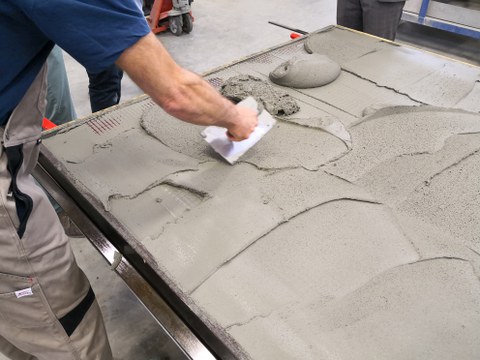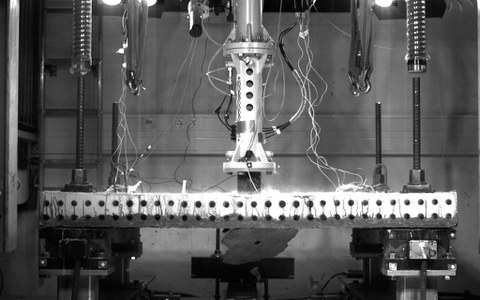Strengthening of plates on the impact-far side
Table of contents
Project data
| Titel | Title Promotionsprojekt A5/I: Verstärkung von flächigen Massivbauelementen gegen Impakt auf der impaktabgewandten Seite als Teilprojekt des GRK 2250 | Doctoral projekt A5/I: Strengthening of plane RC elements against impact on the impact-far side as part of RTG 2250 Förderer | Funding Deutsche Forschungsgemeinschaft (DFG) / GRK 2250 Zeitraum | Period 05/2017 – 04/2020 (1. Kohorte | 1st cohort) Leitung | Project manager Prof. Dr.-Ing. Dr.-Ing. E.h. Manfred Curbach Bearbeiter | Contributor |
Report in the annual report 2020
Carbon-reinforced concrete and hybrid reinforcement vs. impact

Strengthening of a reinforced concrete slab for an impact test
In the first cohort of the Research Training Group 2250 (GRK2250/1), subsequently applied strengthening layers made of carbon-reinforced concrete, as well as carbon-fiber fabrics in a high-strength polymer fiber concrete matrix (SHCC – strain hardening cement composite), were used on the component side facing away from the impact. Both strengthening layers showed a very good effect by significantly increasing the perforation resistance of the reinforced
concrete plate. Furthermore, the stiffness of the structural element was improved by the
application of the strengthening layers.
Within the scope of the investigations carried out so far, a select group of reinforced concrete plates were considered for strengthening, in which only flexural reinforcement was used. Based on these specimens and a couple of reference plates made of reinforced concrete, the development of a damage description started, which allows the quantification of the structural damage caused by an impact event. Furthermore, the continuing development of an existing engineering model for the description of impact events on reinforced concrete structures was worked on. For this purpose, a simplified mechanical substitute model consisting of masses, springs and dampers was used, which was extended by the component of the strengthening layer. Experimental results as well as own numerical simulation data could be used as a basis for this.
The more detailed examination and systematic expansion of these results are planned within the second cohort of the Research Training Group 2250. One main focus of the investigation focuses on the question, in which way the perforation resistance can be explicitly increased by a subsequently applied strengthening layer? Considering that before only a qualitative increase could be determined. In addition to the strengthening of reinforced concrete plates with bending reinforcement exclusively, the experimental test program is also systematically extended to base plates with additional stirrup reinforcement. As in the previous cohort, a hybrid strengthening layer consisting of carbon-fiber fabric and an SHCC matrix is also used in addition to carbon-reinforced concrete. Finally, the existing damage description and the engineering model are supplemented and validated, especially concerning the additional effect of the shear reinforcement.
Report in the annual report 2019
No perforation wanted

View under the specimen after the experiment
Within the framework of the Research Training Group 2250/1 “Mineral-bonded composites for enhanced structural impact safety”, a high-strength polymer fiber concrete matrix (HS-SHCC - high strength - strain hardening cement composite) has been used as a feasible strengthening layer on a specimen subjected to impact loading. The layer was placed on the not impacted specimen side. The reinforcing effect of HS-SHCC was investigated with and without additional textile reinforcement. Carbon-fiber textile-reinforcement was used as a reinforcement material. Previous investigations conducted by the Institute of Building Materials have shown that the matrix material used for the strengthening layer, i.e. the HS-SHCC, can only achieve its full potential when very large deformations occur. Due to this reason, the reinforcing material was specifically modified. For the current investigations, a continuous fiber fabric consisting of polymer fibers was produced and used as reinforcement for the HS-SHCC.

Bottom of plates after the experiment, left: reinforced concrete, right: RC plate strengthened with HS-SHCC and polymer fabric
In order to investigate the newly developed material combination of the reinforcing layer, a two-centimetre thick layer was applied to two reinforced concrete slabs. The surface preparation of the plates involved roughening the side of the component to be strengthened to create a good bond between the component and the strengthening layer and pre-wetting the component surface to prevent the freshly applied material from drying out. The specimens were then tested under the same conditions in the drop tower facility located at the Otto-Mohr Laboratory of the Technische Universität Dresden. For this purpose, a cylindrical impactor was accelerated by compressed air and shot at the plate-shaped specimen. This form of loading is generally referred to as impact loading. The experimental investigations showed that the use of HS-SHCC completely prevented the concrete from spalling on the reinforced component side. Furthermore, it was found that the reinforcing layer was strongly deformed by the impact load, which indicates that the load bearing capacity of the HS-SHCC could be used.
These investigations are to be continued in the coming months as part of the 2250/1 Research Training Group. Different variants of the matrix material will also be investigated. The aim here is to answer the question of whether a high-strength or a normal-strength matrix material is more suitable.
Report in the annual report 2018
Fiber concrete under extreme load

RC slab strengthened with fiber-reinforced concrete during the experiment
Fiber reinforced concrete or steel fiber reinforced concrete have long proved to be extremely resistant to a large number of different loads. Due to its considerable robustness this material is popular in buildings that require high security and safety features. Especially when buildings need to be protected against explosions or similar loads, steel fiber-reinforced concrete is often selected. Due to its high ductility compared to plain concrete, it is very well suited to dissipate energy through deformation.
This ductile material behaviour could be further increased by the addition of polymer fibers, as proposed by the Institute of Construction Materials at the TU Dresden. This novel idea is currently the subject of a joint research programme, the Research Training Group 2250/1 “Mineral-bonded composites for enhanced structural safety”, which is investigating its use for the strengthening of existing reinforced concrete structures against impact loads. This polymer fiber-reinforced concrete, also known as strain hardening cement composite (SHCC), can withstand extreme deformation while maintaining its structural integrity. Such large deformation capacity, in turn, enables the structure to dissipate large amounts of energy under impact without failure of the load-bearing component.

Underside of a RC slab strengthened with fiber-reinforced concrete after the impact test
In the current experimental program, the SHCC is being further developed, as a high strength - strain hardening cement composite (HS-SHCC); on the one hand as a matrix material for carbon-fiber reinforcement, and on the other hand as a plain strengthening material.
For the experiments in the drop tower facility of the Otto Mohr Laboratory, one reinforced concrete plate was strengthened with a layer made of HS-SHCC and another plate was strengthened with a layer made of HS-SHCC with additional carbon-fiber reinforcement. After that, the plates were tested under dynamic loading. Reference experiments with reinforced concrete plates without additional strengthening layers should show the effectiveness of the strengthening. Based on the experimental results currently obtained, the reinforcement layers will be optimized with regard to impact resistance. The focus is on the matrix material as well as on the textile reinforcement used.
Report in the year book 2017
A different way of absorbing shocks

Short hooked steel fibers
For a long time, steel fibers have been used in different shapes and lengths to reinforce concrete. This material is known as (steel) fiber-reinforced concrete (FRC). Steel fibers are used because plain concrete, especially highand ultrahigh-performance concrete, fails in an extremely brittle manner. Adding steel fibers makes the failure much more ductile. The next step in the research will focus on the use of other fiber materials, e.g. polymer fibers, as reinforcing the material. These new reinforcing materials are not so good for static loading conditions because they creep. Nevertheless, they work very well under dynamic load conditions, e.g., impact loads. Such impact loads have a duration of just fractions of a second. In this case, the negative creep behaviour is negligible, and many applications are possible. A proven example is, e.g. nets made out of polymers to trap falling rocks. The use of polymers as (short) fibers in cementitious matrixes, known as strain-hardening cement-based composites (SHCC), is still relatively new.
This field of science is extremely complex, and it is comprised of a large number of topics. Due to this, a Research Training Group funded by DFG was founded at TU Dresden in 2017. Here, 13 doctoral students out of different institutes and different disciplines work together. The project deals with the strengthening of the rear side of structures with cementitious-based composites. Until now, there were some preliminary experiments with cement based matrixes and short fibers out of steel and polypropylene (PP). Fiber contents and fiber shapes were varied. The modification of the mixture also changes its properties. That was visible during specimen fabrication. Good workable concrete was produced when adding short steel fibers. The same volume of polypropylene fibers resulted in a concrete that was extremely stiff and extremely difficult to process. The experiments were conducted at the accelerated drop tower facility of the Otto Mohr Laboratory. In this impact experiments, the FRC plates showed a potential to prevent spalling.
In 2018, the first experiments with new fiber materials shall be conducted to investigate the efficiency of these materials under impact loads. These investigations shall be done at the material and structural level. In this way, a good basis for further research will be created.
